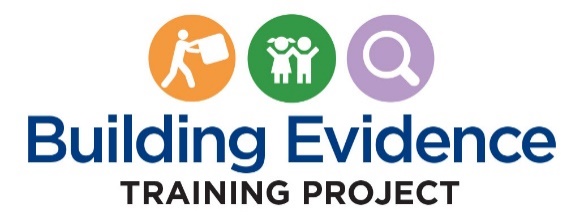Building Evidence Training (BET) Project Usability Testing
Fast Track Generic Clearance for Collection of Qualitative Feedback on Agency Service Delivery
Unit_1_Post_Test OMB Final
Building Evidence Training (BET) Project Usability Testing
OMB: 0970-0401
OMB # 0970-0401
Expiration Date: 05/31/2021
PAPERWORK REDUCTION ACT OF 1995 (Pub. L. 104-13) STATEMENT OF PUBLIC BURDEN: The purpose of this information collection is to gain feedback on the course content and delivery. Public reporting burden for this collection of information is estimated to average .12 hours per response, including the time for reviewing instructions, gathering and maintaining the data needed, and reviewing the collection of information. This is a voluntary collection of information. An agency may not conduct or sponsor, and a person is not required to respond to, a collection of information subject to the requirements of the Paperwork Reduction Act of 1995, unless it displays a currently valid OMB control number. If you have any comments on this collection of information, please contact the Building Evidence Training Project at: betp@jbsinternational.com
Designing and Implementing Evidence-Supported Interventions in Child Welfare

Unit
1 Post-test:
Introduction to Evidence-Informed Processes for Designing and Implementing Changes in Child Welfare Practice
Instructions:
The following post-test questions are designed to capture your knowledge gained about the concepts presented after reviewing the unit content.
Questions
Which of the following is an example of an intervention, as defined in this unit?
A parenting program to provide information on basic childcare skills, problem solving, home management, and social interaction skills.
A home-visiting program for pregnant women and caretakers of young children designed to support maternal and child health, positive parenting practices, safe home environments, and access to services.
A training program for professionals to increase levels of comfort and perceived competence in screening for and addressing child abuse and neglect.
A program to facilitate collaboration between the local child welfare agency and the courts to increase rates of successful family reunification.
All of the above.
Select the answer that best defines “evidence-supported intervention.”
The integration of the best available research evidence with clinical and child welfare practice expertise and child and family characteristics, culture, and preferences.
The complete process of identifying, describing, and analyzing strengths and problems and then testing, implementing, learning from, and revising strategies to improve performance.
A research study that employs treatment and comparison groups to determine the effectiveness of interventions.
A well-defined program, practice, policy, or other strategy that has shown the potential, through rigorous evaluation, to improve outcomes for children and families.
A child welfare organization wants to try an evidence-supported intervention. Which of the following are implementation issues?
Does the intervention address the problem the agency is trying work on?
Will the intervention be well received by families in the local community?
Will the agency protect staff time to allow them to receive the significant training required to deliver the intervention?
Will adaptations required to make the intervention consistent with state policy reduce the intervention’s effectiveness?
All of the above.
Select the answer that correctly orders the major stages of implementation.
Exploration, Installation, Initial Implementation, and Full Implementation.
Initial Implementation, Full Implementation, Exploration, and Installation.
Installation, Exploration, Initial Implementation, and Full Implementation.
Exploration, Initial Implementation, Full Implementation, and Installation.
Installation, Initial Implementation, Exploration, and Full Implementation.
Select the answer that is consistent with the fundamental principles of implementation science presented in Unit 1.
Implementation science principles are well established and will not evolve with the release of new research.
Implementation frameworks diminish the need for workers’ expertise.
Successful implementation of interventions requires teams with diverse expertise, skills, and perspectives.
All of the above.
True/False. Only frontline staff play a crucial role in implementation of evidence-based practices.
True
False
A child welfare agency is implementing a new intervention by following a strategic model that provides a systematic way to develop, manage, and evaluate interventions. This suggests that:
The agency is not getting input from all levels of staff.
The next step is to conduct a review of data, outcomes, and indicators to increase agency efficiency.
There is strong evidentiary support for the intervention.
The agency is using an implementation framework to guide their work.
All of the above.
Select the answer that correctly states the Active Implementation Formula.
Promising Practices (The “What”) ✕ Effective Practices (The “How”) = Positive Outcomes for Children.
Effective Interventions (The “What”) ✕ Effective Implementation (The “How”) = Positive Outcomes for Children.
Research Evidence (The “Why”) ✕ Effective Management (The “How”) = Positive Outcomes for Children.
Poor Outcomes (The “Why”) ✕ Effective Interventions (The “How”) = Positive Outcomes for Children.
Which of the following is identified in Unit 1 as a key challenge to using evidence-supported interventions to improve child welfare outcomes?
The findings of rigorous evaluation studies suggest evidence-based practice is less suitable in child welfare than other social service fields.
Improvements to child welfare and social service outcomes are not possible without state-level legislation.
The number of child welfare interventions currently supported by evidence is very limited.
Without additional training sites, significant adoption of new interventions is unlikely.
All of the above.
Which of the following is a benefit of participating in the implementation of evidence-supported interventions?
Child welfare professionals at all levels can improve their practice by participating in the implementation of ESIs to positively affect children and families.
Child welfare professionals achieve better outcomes for children and families.
Child welfare frontline staff and supervisors can make contributions that will improve the likelihood of effective implementation.
All of the above.
Unit 1 Post Test
| File Type | application/vnd.openxmlformats-officedocument.wordprocessingml.document |
| Author | Karen Fenton-Leshore |
| File Modified | 0000-00-00 |
| File Created | 2021-01-13 |
© 2025 OMB.report | Privacy Policy